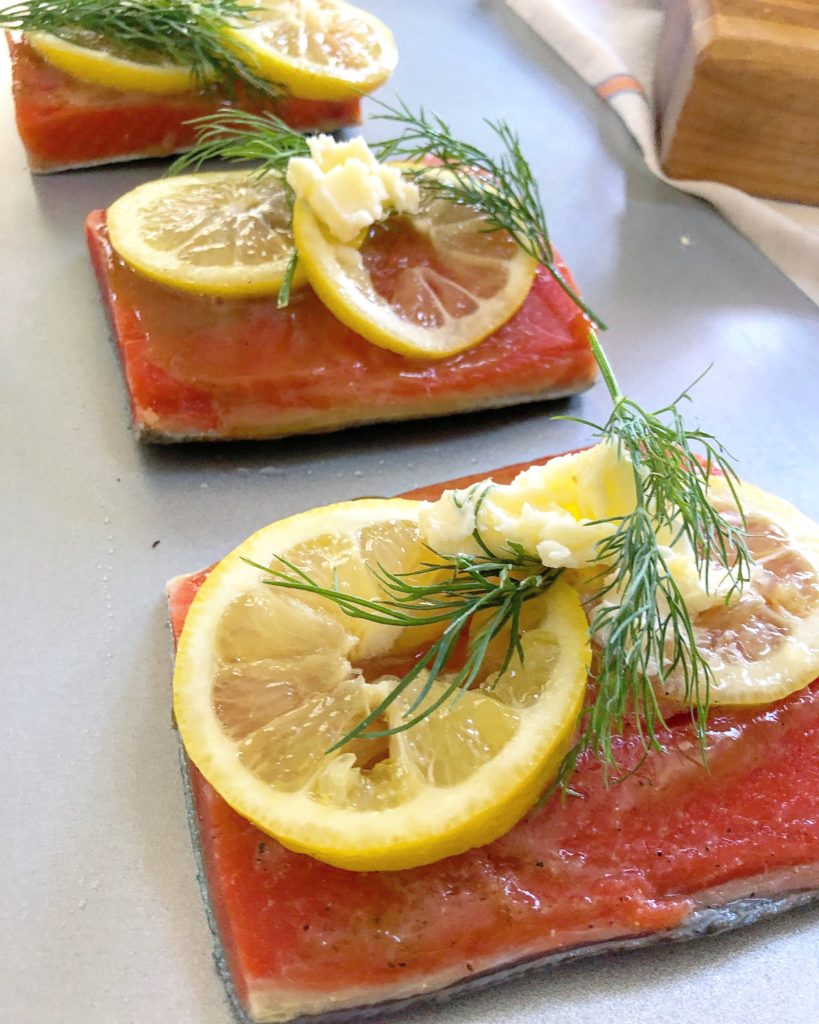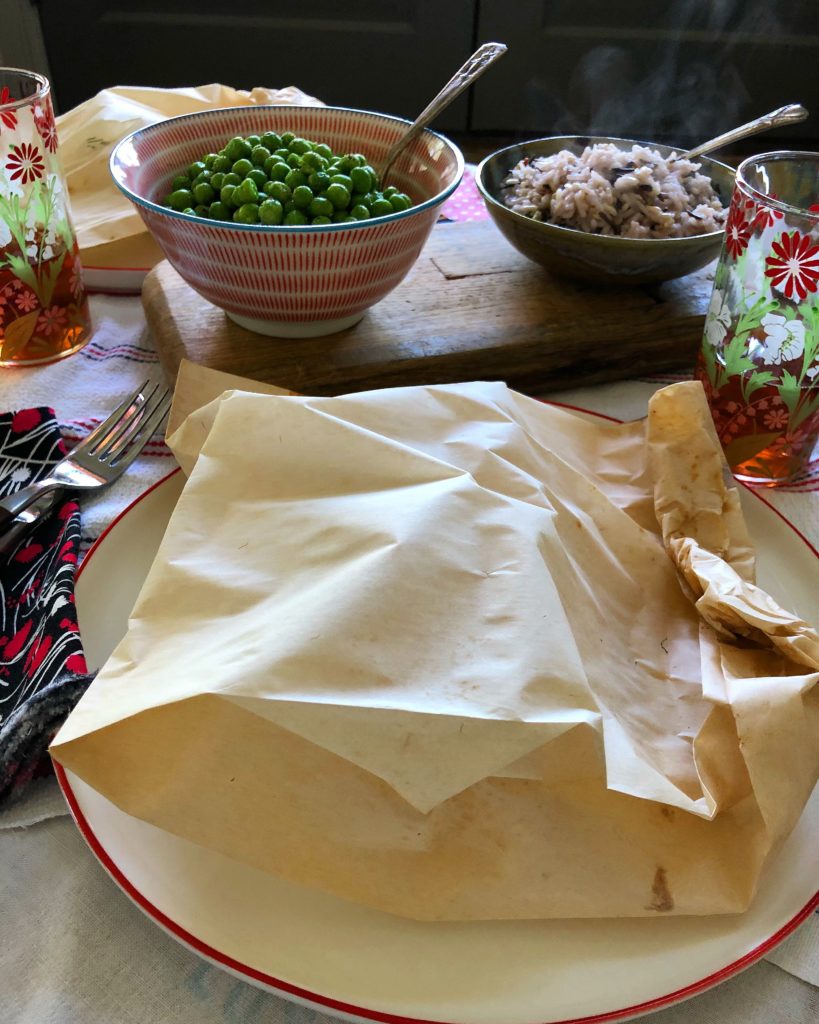
Salmon in a Sack
Sinkology is proud to present Emily Schuermann, our food-loving guest blogger who runs Food for a Year. Emily is here to share some recipes she has created exclusively for the Sinkology blog that reflect her view of a copper sink: simple, timeless, affordable, and beautifully rustic.
“Salmon in a Sack” — sounds a little curious, right? Maybe so, but let me tell you, this recipe is a keeper for sure. Not only is it flavorful and healthy – it’s also crazy easy to make AND even easier to clean up.
First of all, “Salmon in a Sack” needs only six ingredients:
- salmon
- lemon
- dill
- dijon mustard
- brown sugar
- butter
With such a shortlist, it’s important to use quality produce and bold flavors. If you’re not a fan of dijon or dill, we’ll talk substitutions in a minute.
I used 6 ounce portions of frozen, wild caught salmon that I thawed according to package instructions. Pat the salmon filets dry and sprinkle with salt and pepper.
In a small bowl combine brown sugar and dijon mustard. Brush a thin layer of the mustard/brown sugar mixture on the top side of the salmon. Last, top with two slices of lemon, two sprigs of fresh dill and a pat of butter.
Now for the “sack” portion of the recipe, most groceries stores carry parchment paper sacks ((in the same section you find rolls of foil and plastic wrap)), but if you can’t find them, parchment paper will work nicely. I’ll share details about turning a sheet of parchment paper into a sack in the “notes” section of the recipe card located below.
Slide one lemon & dill topped salmon filet into the middle of one sack. Without flattening the sack or pressing the air out of the sack, close and tightly fold the opening shut.
Place the closed salmon-filled sacks on a baking sheet and into a preheated 350° oven for 12 to 15 minutes.
Allow the salmon sacks to rest for one minute before serving.
To serve, place one un-opened sack in the middle of each dinner plate, using scissors, snip each bag open right before digging in.
This “salmon in a sack” is moist and tender thanks to steaming these fillets in a sealed pouch of parchment. The flavor is off the charts – with just a hint of lemon and dill, a nice zing from the dijon and a subtle sweetness from the brown sugar.
One last thing, this recipe is made for substitutions. It’s very versatile and can be easily adapted to your personal taste preferences. Cooking time, temp and the procedures remain the same, of course, but here are a few variations you may like:
- honey + soy sauce (2 T each)
- butter, chives + crushed red pepper flakes
- tomato slice, basil leaves + ½ t minced garlic
- greek seasoning blend + cherry tomatoes
- teriyaki + thinly sliced onions & celery
You could even change the type of fish, just be sure to follow recommended cooking times.
Another bonus for this recipe is just how easy it is to clean up! Since everything is contained in a sealed sack, once dinner is over, there’s no baked-on, burned bits to scrub or soak. Just a quick wipe down and kitchen chores are finished!
The ease of this recipe really reminds me of just how simple it is to care for my copper farmhouse kitchen sink. Most days, I just take a few seconds to rinse all the crumbs and scraps down the drain. But occasionally, I use a soapy sponge and a spray of warm water to freshen up the sink. The kids love Sinkology’s copper armor spray and often ask if they can “make the sink shine” which is fine with me! Now, you know it has to be painless if the kids are asking to do it!
- 4, 6 ounce salmon fillets (if frozen, thawed according to package instructions)
- 8 slices of lemon
- 4-8 small sprigs of fresh dill
- 2 T dijon mustard
- 2 T brown sugar
- 2 T salted butter
- sea salt & black pepper
- *optional, crushed red pepper flakes
- I used 6 ounce portions of frozen, wild caught salmon that I thawed according to package instructions. Pat the salmon filets dry and sprinkle with salt and pepper.
- In a small bowl combine brown sugar and dijon mustard. Brush a thin layer of the mustard/brown sugar mixture on the top side of the salmon. Last, top with two slices of lemon, two sprigs of fresh dill and 1/2 T butter.
- Now for the "sack" portion of the recipe, most groceries stores carry parchment paper sacks ((in the same section you find rolls of foil and plastic wrap)), but if you can't find them, parchment paper will work nicely*.
- Slide one lemon & dill topped salmon filet into the middle of one sack. Without flattening the sack or pressing the air out, close and tightly fold the opening shut.
- Repeat for remaining fillets.
- Place the closed salmon-filled sacks on a baking sheet and into a preheated 350° oven for 12 to 15 minutes.
- Allow the salmon sacks to rest for one minute before serving.
- To serve, place one un-opened sack in the middle of each dinner plate, using scissors, snip each bag open right before digging in.
- Serves 4
- * If you can't find parchment paper bags, form a pouch by using 4 12" x 20" pieces of parchment paper. Fold each piece in half. Place the salmon in the middle of one half of the parchment paper. Top with ingredients, according to recipe directions. Fold the top half of parchment paper over the salmon, being sure to leave airspace between the paper and the fish. Tightly fold each of the three open sides together forming a closed package. Follow the remaining directions as stated above.




If you have any additional questions during your search for the perfect copper sink, our Sinkologists are here to help. Contact us or follow us on Facebook, Houzz, Pinterest, or Instagram for more helpful tips and design ideas.




